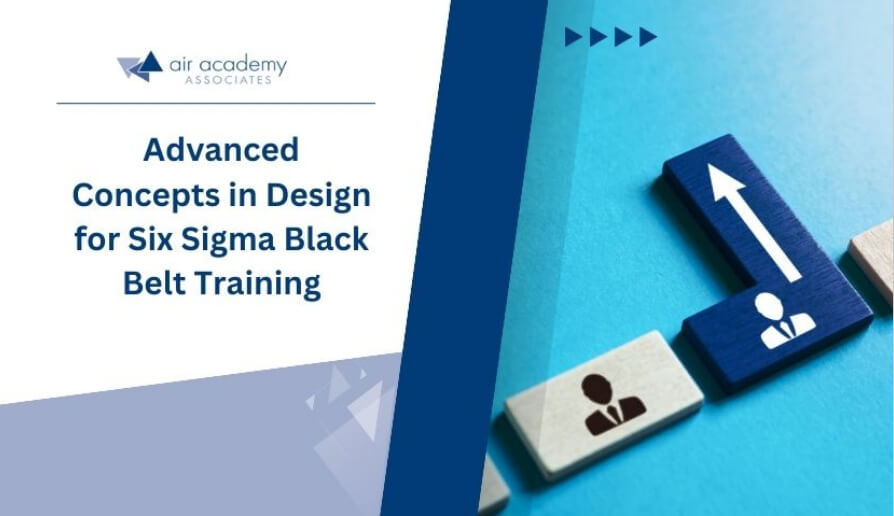
Six Sigma is recognized globally for its rigorous approach to quality management and process improvement, which is essential for organizations aiming to achieve outstanding quality and operational efficiency. Within this rigorous framework, the Six Sigma Black Belt plays a pivotal role in driving significant changes and incorporating advanced concepts in design to enhance organizational performance.
This article provides an in-depth look at Six Sigma Black Belt Training, highlighting the critical roles, responsibilities, and sophisticated design concepts integral to this level of Six Sigma proficiency.
Key Takeaways
- Six Sigma Black Belts play a pivotal role in integrating advanced design concepts to enhance quality management and operational efficiency within organizations significantly.
- Design for Six Sigma (DFSS) employs systematic methodologies like QFD and FMEA to ensure designs meet customer needs from the start, drastically reducing defects.
- Advanced statistical analysis enables Six Sigma Black Belts to uncover patterns in complex data sets, facilitating data-driven decisions that improve and control processes.
- Lean principles and Six Sigma techniques empower Black Belts to eliminate waste and optimize processes, ensuring a seamless flow of value to customers.
The Essence of Six Sigma Black Belt
Six Sigma Black Belts are the architects of change, serving as leaders and innovators in the relentless pursuit of excellence. They are the vital connectors between the visionary Master Black Belts and the foundational Green Belts, focusing intently on execution and the practical aspects of Six Sigma implementation. Their role is to lead and inspire, fostering a culture of continuous improvement and innovation within the organization.

Image Source: Pexels
The essence of the Six Sigma Black Belt role is multifaceted, encompassing leadership, innovation, practical execution, and cultural transformation. Their ability to lead change, mentor teams, and drive significant improvements makes them invaluable assets to any organization committed to excellence and continuous improvement.
Through their efforts, Black Belts helps to create a resilient organization that is well-equipped to meet the challenges of the modern business landscape, driving efficiency, quality, and customer satisfaction to new heights.
Advanced Concepts in Design

Image Source: Freepik
The Six Sigma Black Belt is a symbol of mastery in integrating advanced concepts in design, serving as the catalyst for profound organizational transformation. These professionals are equipped with many sophisticated analytical tools and Lean concepts, enabling them to refine business functionality and curtail process variation.
This meticulous approach ensures the delivery of products and services of unparalleled quality, leading to enhanced customer satisfaction and organizational success.
Design for Six Sigma (DFSS)
DFSS is a systematic approach to designing or redesigning products and processes, grounded in meeting customer needs and expectations from the very start. Unlike traditional Six Sigma, which focuses on improving existing processes, DFSS starts with a clean slate, emphasizing the importance of design quality to prevent problems before they occur.
It incorporates tools such as Quality Function Deployment (QFD) and Failure Mode and Effects Analysis (FMEA) to translate systematically customer needs into design requirements and identify potential failure points early in the design process. This proactive approach to design optimizes the process, significantly reducing the likelihood of defects and ensuring the delivery of high-quality, reliable outputs.
- Quality Function Deployment (QFD): QFD meticulously translates customer needs (Voice of the Customer) into specific engineering characteristics (technical requirements) for each stage of product development and process improvement. A deeper dive into QFD involves using the House of Quality matrix, which facilitates the prioritization of customer needs and the identification of relationships between those needs and product/process features. This ensures that development efforts are aligned with what customers value most.
- Failure Mode and Effects Analysis (FMEA): This structured approach identifies, prioritizes, and mitigates potential failures in product design and manufacturing processes. The methodology is enhanced by quantifying each failure mode’s severity, occurrence, and detectability, allowing teams to focus on reducing risks associated with critical failures before they happen. This proactive risk assessment is crucial for ensuring the reliability and quality of outputs.
Statistical Analysis and Control
Advanced statistical methodologies are the backbone of the Black Belt’s arsenal, allowing them to dissect complex datasets, unearth patterns, and make data-driven decisions to enhance and control processes. They employ regression analysis, hypothesis testing, and control charts to understand the relationships between variables, test assumptions, and monitor process performance over time.

Image Source: Freepik
This analytical prowess enables Black Belts to pinpoint the root causes of variability and waste, formulate optimal solutions, and sustain improvements, contributing to the organization’s overall efficiency and effectiveness.
- Enhanced Statistical Methods: Beyond the foundational statistical tools, Black Belts utilize more complex analyses such as the Design of Experiments (DOE), which allows for the systematic and simultaneous investigation of multiple variables to determine their effect on a given response. This advanced statistical method provides a more nuanced understanding of the process behavior, enabling the optimization of process settings for peak performance.
- Process Capability Analysis: Another critical aspect is assessing the capability of a process to produce outputs consistently within specification limits. Tools like Cp, Cpk, and other process capability indices offer a quantitative measure of a process’s ability to meet customer requirements, guiding continuous improvement efforts.
Lean Principles
Black Belts seamlessly integrates Lean principles to purge non-value-added activities and optimize workflows, creating a conducive environment for efficiency and productivity to thrive. They utilize Lean tools like Value Stream Mapping to visualize and analyze the flow of information and materials through the process, identifying bottlenecks, redundancies, and opportunities for improvement.
By implementing Lean strategies such as 5S (Sort, Set in order, Shine, Standardize, Sustain) and Kanban, Black Belts facilitates organizational agility, reduces lead times, and ensures a smooth, uninterrupted flow of value to the customer.
- Kaizen and Continuous Improvement: While 5S and Kanban are essential for creating efficiency, incorporating Kaizen—a philosophy of continuous, incremental improvement—into the Lean methodology encourages a culture where all employees are actively seeking ways to improve processes, reduce waste, and enhance productivity. This approach fosters a dynamic environment of ongoing improvement and innovation.
- Value Stream Mapping (VSM): To gain further insights into Lean tools like VSM, it’s crucial to map the current state of a process and design a future state that eliminates non-value-added steps and optimizes the flow of information and materials. This involves a detailed analysis of the entire value stream, identifying opportunities for significant improvements in lead time and process efficiency.
By adopting these enhanced methodologies and tools, Six Sigma Black Belts can significantly improve their ability to design high-quality, efficient processes and products that meet or exceed customer expectations. These advanced concepts further solidify the Black Belt’s leadership role in driving operational excellence and organizational success.
Risk Management and Mitigation
Risk management is integral to the role of a Black Belt. They employ risk assessment tools like FMEA to identify potential failures in a process or product design and prioritize them based on their impact, occurrence, and detectability.
By proactively addressing risks and implementing robust control measures, Black Belts safeguards the organization against unforeseen adversities and ensures the sustainability of improvements.
Continuous Improvement and Innovation
Black Belts champion the cause of continuous improvement and innovation, fostering a culture where every organization member is empowered to question the status quo and contribute to enhancement initiatives.
They facilitate brainstorming sessions, encourage the sharing of ideas, and leverage creative problem-solving techniques like TRIZ to generate innovative solutions to complex problems. This relentless pursuit of excellence ensures the organization’s adaptability, resilience, and sustained growth in a dynamic business landscape.
Qualities of a Successful Six Sigma Black Belt

Image Source: Pexels
A successful Six Sigma Black Belt is a professional well-versed in Six Sigma philosophies and principles, including supporting systems and tools. They are the harmonious blend of self-motivation, excellent communication skills, profound business understanding, and leadership prowess.
They are the change agents who understand customer needs and link initiatives to targeted business outcomes, driving the organization toward its goals with unwavering dedication and insight.
Black Belts should demonstrate team leadership, understand team dynamics, and assign team members roles and responsibilities. They have a thorough understanding of all aspects of the define, measure, analyze, improve, and control (DMAIC) model following Six Sigma principles. They also have basic knowledge of lean enterprise concepts, can identify non-value-added elements and activities, and can use specific tools.
Training and Certification

Image Source: Freepik
Embarking to become a Six Sigma Black Belt involves rigorous training and certification, validating one’s expertise in Six Sigma principles and tools. Achieving this certification is a testament to one’s skills and competitive advantage, opening doors to new opportunities, higher positions, and increased remuneration.
The Certified Six Sigma Black Belt (CSSBB) examination is a comprehensive test consisting of multiple-choice questions that measure comprehension of the Body of Knowledge. The examination is in English, Mandarin, computer-delivered, and paper and pencil formats.
Candidates must have worked full-time, paid roles and have three years of on-the-job experience in one or more CSSBB Body of Knowledge areas. Additionally, candidates must complete at least one Six Sigma project and submit a project affidavit or two projects with signed affidavits.
The certification program is accredited by the ANSI National Accreditation Board (ANAB) under the ISO 17024 standard, demonstrating impartial, third-party validation that the certification program has met recognized national and international credentialing industry standards.
Enhancing Quality Management Through Six Sigma Black Belt Training: Real-World Applications

Image Source: Pexels
Six Sigma Black Belt Training is a cornerstone in quality management and process improvement, providing professionals with the tools and methodologies necessary to drive significant organizational change. This advanced training equips individuals with the skills to implement complex projects that enhance operational efficiency, reduce waste, and improve product quality across various industries.
To illustrate the practical application and effectiveness of Six Sigma methodologies, we explore several case studies across different sectors.
Finance Sector: Streamlining Operations efficiency
A notable project in the finance industry focused on reducing underwriting resubmits by over 20%. This initiative led to millions of dollars in annual savings for a call center that dealt with thousands of inbound calls daily, showcasing the profound impact of Six Sigma on operational efficiency and cost reduction.
Manufacturing Industry: Boosting Product Quality and Efficiency
In the manufacturing sector, one project successfully increased the first run parts from 60% to 90%. This case study highlights the significant role of Lean Six Sigma in enhancing product quality and operational efficiency, demonstrating how advanced design concepts can lead to substantial improvements in manufacturing processes.
Technology Field: Enhancing Online Services
A technology case study involves a cellular service provider addressing challenges with their online top-up system using the DMAIC process. The project achieved a registration success rate of 91% and a top-up success rate of 90%, thereby increasing annual revenue by more than $300,000. This example underscores the applicability of Six Sigma methodologies in solving complex problems in the digital space and enhancing customer satisfaction.
Healthcare Sector: Improving Patient Care and Safety
Lean Six Sigma methodologies in healthcare were applied to manage and improve patient care and safety without compromising the supply of N95 masks during the pandemic. Utilizing tools like RACI and Swimlane diagrams facilitated effective process management, illustrating Six Sigma’s potential to address critical challenges in healthcare settings.
Oil and Gas Industry: Optimizing Financial Operations
An oil and gas company utilized Six Sigma basics to significantly reduce Days Sales Outstanding (DSO) to under 100 days across most sites. This project resulted in over a million dollars in savings, highlighting the financial benefits of applying Lean principles to improve the sector’s cash flow and operational efficiency.
Public Sector: Enhancing Infrastructure Management
The City of San Antonio’s initiative to increase payments for street maintenance by applying Lean Six Sigma showcases the methodology’s versatility. This case study demonstrates that Six Sigma can effectively be applied beyond the private sector, benefiting public administration and infrastructure management.
Conclusion
The role of a Six Sigma Black Belt extends beyond mere title to embody a deep commitment to excellence, continuous learning, and the application of sophisticated strategies for process and quality improvement. This role involves applying advanced design concepts to achieve and sustain superior organizational success. For individuals aiming to effect meaningful change, Six Sigma Black Belt Training offers comprehensive insights and tools for excelling in this challenging yet rewarding field.
Our DFSS Black Belt Advanced Test Design course at Air Academy Associates offers an extensive exploration into Six Sigma, providing you with the knowledge and skills to drive significant improvement and innovation within your organization. By engaging with this course, you commit to learning and mastering Six Sigma principles, positioning yourself to lead successful initiatives and achieve exceptional outcomes. Begin your journey to becoming a pivotal force in your organization’s quest for excellence.


